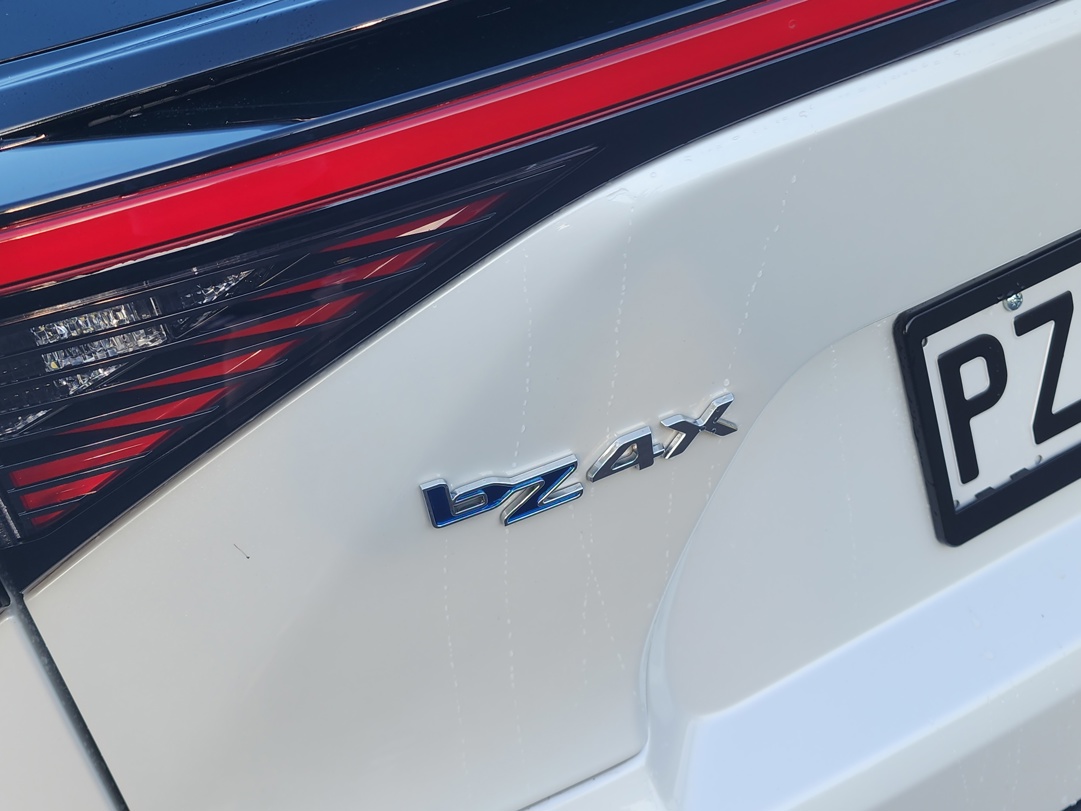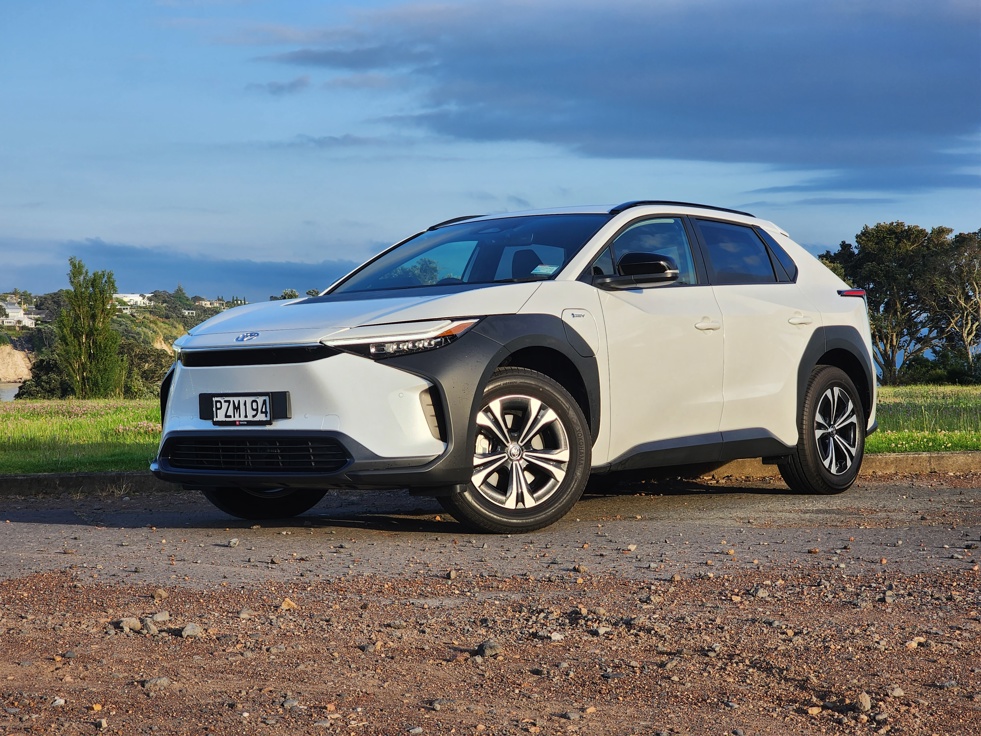Toyota’s first-ever bespoke pure-electric production vehicle, the bZ4X, has taken its time getting to New Zealand. Is it any good? We thought it only fair to take our time in deciding.
We’re spending an extended period in the bZ4X: two months to really get to grips with the SUV that brings the world’s leading hybrid brand into the battery-electric world and goes head-to-head with keyboard Shift/Caps Lock keys.

The bZ4X (yeah, you try typing it) rides on a bespoke EV platform called e-TNGA. It’s a joint venture with Subaru, which has its own version called Solterra. We’re driving that one soon too.
The Toyota name doesn’t trip off the keyboard or tongue all that smoothly, but it tells you what you need to know. The first bit, “bZ’, denotes beyond zero, which is the company’s new brand for its zero-emissions vehicles; there will be nine more bZ models globally over the next two years and most are our heading our way. The “4” indicates size, which in this case aligns the car with the RAV4. And the “X” just means it’s a crossover SUV.

The 4 doesn’t mean four-wheel drive, because our test car isn’t. While Subaru’s sister model is AWD only, Toyota NZ has gone for a broader model range that opens with this single-motor Pure FWD. For $72,990 you get a 71.4kWh battery (standard right across the range) and front-mounted eAxle with 150kW/266Nm motor.
The 150kW output is on par with the Hyundai Ioniq 5 or Volkswagen ID.4 and the 0-100km/h time of 7.5 seconds is suitably brisk.
Once upon a time (well, 2023) this would have been a $66k vehicle with the Clean Car Discount factored in, but no more. At $73k it still looks like good BEV-value next to comparable two-wheel drive models like the Ford Mustang Mach-E, Hyundai Ioniq 5, Tesla Model Y and Volkswagen ID.4.

We’re yet to deep-dive into the bZ4X, but first impressions are of a car that delivers exactly what you’d expect of a Toyota BEV: it’s smooth, supremely easy to drive and extremely practical.
Those 18-inch wheels are alloy, but also wear aerodynamic covers. Yep, we’ve got a sweet set of hubcaps.
This entry car doesn’t feel particularly fast, although that’s as much to do with the way Toyota has calibrated the powertrain for a linear feel as it is with the numbers: the 150kW output is on par with the Ioniq 5 or ID.4 and the 0-100km/h time of 7.5 seconds is suitably brisk.

The ride is firmer than we were expecting, even on our car’s relatively small 18-inch wheels; be interesting to see whether we get used to it over time. But the payoff is undeniably strong and precise handling; this car steers with real assurance. By the way, those wheels are alloy, but also wear aerodynamic covers. Yep, we’ve got a sweet set of hubcaps.
There’s a big Lexus-like 12.3 screen and the main instrument panel is a bit Buck Rogers.
The $83k bZ4X Motion AWD isn’t a whole lot faster, by the way. It has twin motors, but the single 150kW motor in the Pure is replaced by a pair of 80kW units, for a total of 160kW (0-100km/h in 6.9sec).

A long wheelbase means spacious seating front and rear; there's a pretty decent 452-litre boot that’s 90l shy of a RAV4 (note the coupe-like roofline and minimal rear overhang) but remains properly useful, with a rear seat that folds almost flat for load-through of longer items.
The interior will feel familiar if you’re already driving a Toyota, but there’s still a lot of flair here too. There’s a big 12.3 screen and the main instrument panel is set far forward under the windscreen at the end of long, cockpit-like moulding. The wheel is set low (it sits under the instruments, Peugeot-style), but it all feels nice and natural. This is the the architecture Toyota is using to launch a yoke-type controller and full steer-by-wire soon (not confirmed for NZ though), on both the bZ4X and closely related Lexus RZ.

All bZ4X models have the latest Toyota Safety Sense equipment, including full adaptive cruise, Intersection Collision Avoidance Support and Emergency Steering Assist. Plus "Hey Toyota" voice assistant.
We’ll have to stop short of getting into the fine detail with this car, as it’s a “sample” version (Toyota’s term) that’s not quite aligned with the final NZ specification. Mainly just detail stuff, but the on-board AC charging hardware is not three-phase compatible (which will allow up to 11kW) and the infotainment system is not the full wireless phone projection setup. That kind of thing.

In fact, neither the charging or infotainment systems are terribly happy in our particular car. We’re having a lot of trouble getting the DC port to connect to some public stations (one time was a complete fail), although the AC aspect mostly works fine, save the occasional succession of clicks as it struggles to connect; the lack of reliable DC charging does make us reluctant to take this vehicle on a properly ambitious road trip. Toyota NZ has acknowledged an issue with the car and select DC stations and says it's looking into it with the provider.
The wired (on our car) infotainment can’t maintain a connection to Android Auto for more than a few seconds on some phones and the Bluetooth media player is pretty flaky, too.

Some or all of the above could relate only to our particular early-build vehicle. But it's worth a mention as we go forward.
Especially in context of what may well be the most interesting aspect of our time with the bZ4X: range. There’s been some distance-on-a-charge controversy around the bZ4X overseas, with commentators claiming the real-world range isn’t up to scratch.

The bZ4X’s 71kWh battery is slightly smaller than the class average. Toyota NZ is still quoting an NEDC range figure of 535km for the car, which is a kinder test than the newer WLTP regime. The WLTP figure for Europe is 516km, but we’re yet to see a Kiwi 3P-WLTP number - which will be lower again.
However, we’ve topped the car up to 100 per cent a few times on the office Wallbox and the range indicator typically shows just over 300km.

What to make of all that? Well, in response to that early criticism overseas, Toyota rolled out a few bZ4X updates in October last year, which have indeed been applied to our test car.
The climate control was revised with some efficiency improvements to the hardware, but also to make the range indicator a lot less pessimistic when the air-con is operating. Second, the rather generous battery buffer (8-10 per cent) at the bottom end was reduced, meaning there’s more juice available before the car starts alerting you it’s down to zero. A battery percentage indicator was added to the instrument panel and Toyota says the car now charges faster beyond 80 per cent on DC, for those needed to top right up while travelling.

Our car also wears the update badge of honour: while the first bZ4X models had “Electric” written on the charge port, the updated versions say “BEV”.
It’s early days for us with the bZ4X, but our car maintains a fairly modest overall range figure and the air-con still has a dramatic effect, with up to 80km added to the projected total if you switch it off. So we’re very keen to put it all to a real-world test as soon as possible.

For now, we’re enjoying the bZ4X basics: we reckon Toyota has done a great job of making a mainstream BEV-SUV that looks truly distinctive, yet also still very on brand. It’s good to drive, genuinely useful as a family vehicle and crying out for more kilometres as we charge into 2024. Stay tuned.
BATTERY: 71kWh battery with single electric motor POWER: 150kW/266Nm GEARBOX: Single-speed automatic, FWD 0-100KM/H: 7.5sec RANGE: 535km (NEDC), maximum charge rate 150kW PRICE: $72,990





